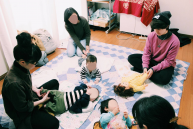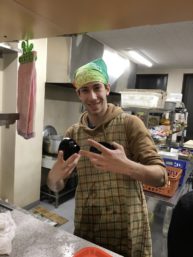My two CIPs were drawing comics at Studio Miura’s Manga Classroom and helping my host mom run her local nursery rhyme and baby massage class. Despite some struggles to communicate, both became highly valuable experiences.
The manga class was a quiet and relaxed gathering of generally younger people working on their comics or illustrations with occasional advice from the teachers present and also snacks. I thought it would be lessons rather than this sort of gathering, and since I knew no art terms in Japanese or what I wanted to get out of it, I struggled for several weeks drawing and communicating inefficiently. I learned to keep a little list of art terms I heard with me for reference, and practiced mustering the courage to ask questions or to repeat things I didn’t understand. It took a long time for me to settle in, but I learned useful ideas on Japanese panel layout etc. for my manga about noh (but with rabbits instead of humans). I want to improve at trying to ask questions.
For baby massage class, my main job was to sing the English translations of Japanese nursery songs while the mothers followed along and massaged their babies. Apparently Warabe-uta Baby Massage is not so common; combining nursery songs with massage (to promote the baby’s physical health and connection with the parent) is a recent concept. The class was made up of a few younger moms and their babies in a very casual setting: although my host mom sometimes used polite language when giving instructions, everyone generally spoke in casual language as peers, including newcomers. (There was a somewhat similar mix of codes in the manga class, so that I was never sure how to speak, as I was no master of politeness.) I started with mild polite language and slipped into casual (usually accidentally). The classroom was a place for the moms to not just interact with their babies, but also consult my host mom, a chiropractor and mother of a two-year-old, as well as chat together. I was surprised that the atmosphere was so casual, and in turn warm, homely, and open.
The “foreigner” and mixed race population in Japan is said to be increasing, and I got to witness this through a friendly mom, whose husband she said was Canadian, and their baby, whose skin, the moms remarked brightly to my surprise, was “definitely white.” The mom cheerfully started a conversation with me to practice her English and ask where I was from.
I also learned about the heteronormative gender dynamics in the group. First, there were no men in the class. It’s not that men can’t do baby massage –my host mom instructed that fathers could participate too– it seems that it’s just not common, just as mothers are still expected nurse children while the father works (yet my host mom holds multiple part-time jobs besides her husband’s). In addition, the strong female presence was felt when my rather quiet host dad suddenly came in and exited the room of already familiar mothers. Lastly, I saw how heterosexual norms can be imposed on infants: a lively baby boy was paying particular attention to me (perceived female by the moms) and a baby girl, so my host mom remarked that he was being “lovey-dovey” (rabu rabu), even though babies can’t have conscious thoughts. This was in contrast to how my host mom said that my toddler host sister was being “friendly” with or liked me.
In my CIPs, I learned about making efforts to communicate, and witnessed the fluidity of mild politeness and casualness as well as developments and gender norms in the family through casual classroom-like gatherings

Me and the mothers massaging the kids (and a baby doll)

